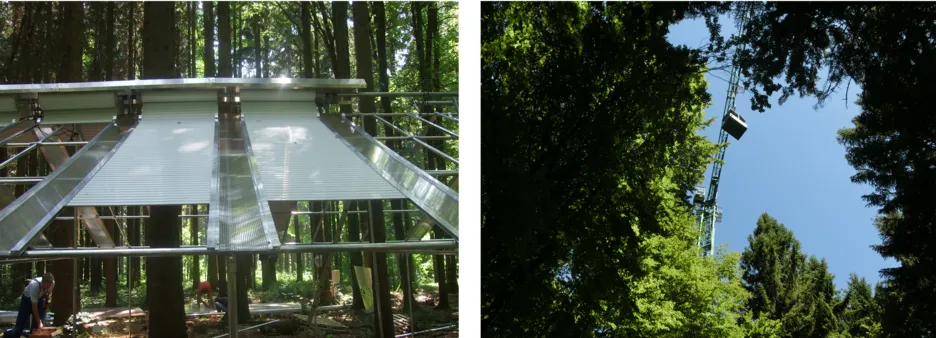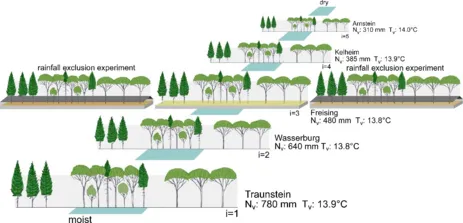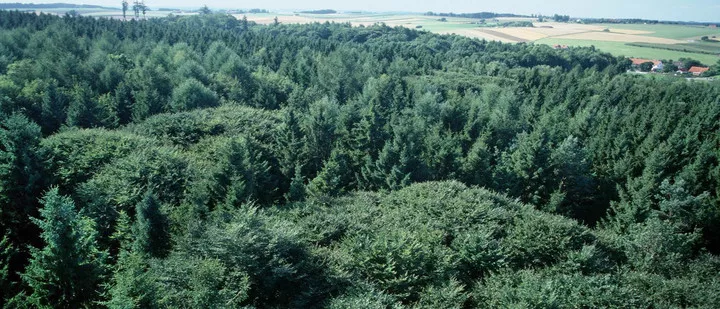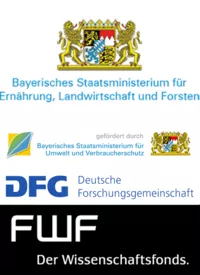KROOF - Kranzberg Forest Roof Project - Interactions between beech and spruce in relation to drought

Extreme drought and dwindling water resources pose new challenges not only to humans, but also to forests. As a result of ongoing climate change, forests worldwide are facing repeated and prolonged droughts leading to massive tree mortality (Hartmann et al. 2018, Schuldt et al. 2020). The current increasing frequency of extremely warm and dry weather episodes will be the norm in the future.
Under these circumstances, the survival of a tree depends primarily on the extent to which tree functions to drought i.e., its resistance, resilience, and recovery functions are compromised (Lloret et al., 2011). To increase tree resilience and stand stability under these adverse conditions, tree species mixes have been promoted in Central Europe for many years (Pretzsch et al. 2010). However, the effects of long-term drought, species-specific physiological differences, adaptation or recovery effects, and the role of species mixing in adult forest stands are still poorly understood.
In Central Europe, spruce (Picea abies [L.] KARST.) and copper beech (Fagus sylvatica L.) are the dominant economic tree species, accounting for 30% of forest areas (Pretzsch et al. 2014). To elucidate the response of these two tree species to long-term and repeated drought in monocultures and mixed plantations, the Kranzberg Forest Roof Project (Kroof) was initiated in 2013, funded by the German Research Foundation (DFG) as well as the Bavarian State Ministry of Food, Agriculture and Forestry and the Bavarian State Ministry of the Environment and Consumer Protection.
The KROOF project includes two experimental approaches:
"KROOF-gradient", which is an experimental plot transect on Bavarian forest sites with different precipitation totals
Using an experimental plot transect through Bavaria, the effects of drought stress on the annual growth of beech and spruce in different mixing ratios are investigated along an ecological gradient from wet to dry sites.
"KROOF-experiment", which is an intensively researched forest site in the Kranzberg forest with experimentally induced drought.
An approximately 0.5 hectare forest area with old beech and spruce stands in the Kranzberger Forest (south of Munich) was selected as a forest research area for the unique long-term rainfall exclusion experiment with single and repeated extreme drought (Kroof experiment as part of the KROOF project).

Kroof gradient was established in 2014 and is composed of a transect of forest sites along a precipitation gradient from northern Bavaria (dry) to southern Bavaria (wet).
The transect consists of seven sites with triplets (pure stand of spruce or beech and mixed stand of beech-spruce, and pine or beech and mixed stand of beech-spruce) from humid southeastern Bavaria to dry northwestern Bavaria, ranging from colline to submontane with comparable soil properties, with mean growing season temperatures of 13.8 -14.0 °C and mean seasonal precipitation of 310 -780 mm. The precipitation gradient provides ideal conditions for hypothesis analysis with respect to water availability as a driving factor. The triplet plots are comparable in terms of location and stand age, fully stocked, single-layered, and located in spatial proximity to each other. (Pretzsch et al. 2014)
"KROOF-experiment", which is an intensively researched forest site in the Kranzberg forest with experimentally induced drought.
An approximately 0.5 hectare forest area with old beech and spruce stands in the Kranzberger Forest (south of Munich) was selected as a forest research area for the unique long-term rainfall exclusion experiment with single and repeated extreme drought (Kroof experiment as part of the KROOF project).
The Kranzberg Forest (longitude: 11° 39′ 42″ E, latitude: 48° 25′ 12″ N, elevation 490 m above sea level) is located in southern Germany, approximately 35 km northeast of Munich. The experimental area is approximately 0.5 ha in size and is situated 490 m above sea level. The annual average precipitation is 750–800 mm, 460–500 mm during the growing season (May–September). The annual average air temperature is 7.8 °C, with a seasonal average of 13.8 °C. At the site, pure and mixed stands of spruce and beech grow on Luvisol loess over tertiary sediments, which provide a high nutrient and water supply (Göttlein et al. 2012; Pretzsch et al. 1998). From a soil depth of approximately 1 m, a relatively dense layer of sandy-silty loam almost completely prevents deeper root growth and thus water uptake (Häberle et al. 2012).
The forest experimental site is part of the long-term Bavarian yield research network (Bavarian State Ministry of Food, Agriculture and Forestry); accordingly, stand structure and Forest growth data are recorded individually and spatially (permanent observation site since 1992). Since 1998, several large projects have been carried out on the forest experimental site.
In addition, a crane (45 m high, 50 m boom) has been located on the test site since 2001, allowing direct access to the treetop for sampling and physiological measurements. The Kranzberger Forst experimental site is integrated into a worldwide canopy crane research network (International Canopy Crane Network, ICCA, Basset & Wright, 2003).

KROOF1 – Rainfall-Exclusion 2014-2018

Twelve plots of mature beech and spruce trees were established at the test site in the Kranzberg Forest. Six plots were equipped with automatically retractable roofs to exclude rain. Between 2014 and 2018, the effects of a prolonged drought on mature beech and spruce trees were investigated in comparison to control trees.
KROOF2 – Recovery 2019-2024

After a 5-year drought period from 2014 to 2018, the study plots were re-watered from mid-2019 to reveal possible recovery effects or irreversible damage in the subsequent years 2019-2024 and to clarify their mechanisms.
KROOF 3 - Legacy and Extremes 2025-2028
In project phase 3 (starting in March 2025), the focus will be on the significance of long-term effects of previous droughts, so-called "legacy effects." For this purpose, trees exposed to drought stress in phase 2 will be repeatedly exposed to extreme drought stress (until complete desiccation). The effects will be compared with trees exposed to drought stress for the first time and control trees exposed to natural rainfall.
KROOF research questions
- How do trees, especially our commercial tree species beech and spruce, cope with prolonged drought events?
- What species-specific response patterns are emerging?
- What influence does species mixture and forest management have?
- What adaptation strategies are developed by the two tree species to water-limiting conditions?
- How do the two tree species respond to re-irrigation?
- Are there differences in recovery?
- What role does the species composition of ectomycorrhizae play in root and tree growth?
- How do legacy effects affect drought tolerance and mortality during repeated extreme drought?
- How do ecophysiological responses to repeated extreme drought differ in beech and spruce?
- How high is the water loss through bark transpiration during drought?
How does tree species mix affect tree hydraulics and water use?
Forestry scientists and biologists from TUM and the Helmholtz Center Munich, as well as other associated national and international research partners, are jointly investigating these questions in the KROOF project.
